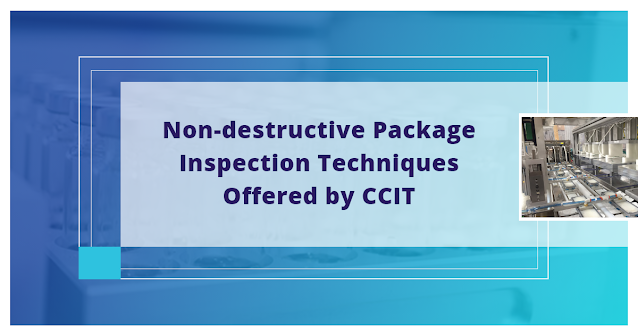Non-destructive Package Inspection Techniques Offered by CCIT
NON-DESTRUCTIVE PACKAGE INSPECTION TECHNIQUES
Vacuum Decay Technology
Vacuum Decay is a non-destructive method for container closure integrity testing (CCIT) that is primarily concerned with package integrity and leak path detection. Vacuum Decay provides quantitative, deterministic, and reliable test findings to assure package integrity in comparison to manual inspection and other non-deterministic test techniques. Vacuum Decay technology can accommodate a broad range of package types in addition to filled and sealed rigid, semi-rigid, and flexible packaging consisting of non-porous or porous materials. Packages are placed in an evacuation test chamber that is properly fitted and equipped with an external vacuum source to conduct the test. The vacuum levels are continuously monitored for deviations from the predetermined target vacuum level. A defect in the package causes air to escape from the package and into the test chamber. On the other hand, packages that are defect less hold in the air and maintain a consistent chamber vacuum level. Years of research have shown vacuum decay technology to be one of the most effective and accurate vacuum-based leak detection methods.
Airborne Ultrasound Technology
Airborne Ultrasound is an ASTM test method F3004 and FDA recognized standard for evaluating seal quality integrity. These tests are primarily carried out to provide pouches, flexible packaging, and tray seals with improved seal quality inspection. High frequency sound waves are used to test the seal quality of the pouch by passing them through the seal area. The test yields a simple pass or fail result of seal quality. After the package has been sealed, channel defects, misaligned seals, incomplete seals, and missing seals can all be found using a linear scan analysis of the seal region. The product can be taken out of the packaging and modified right away if the system detects a packaging defect. It is also possible to identify and solve process-related defects immediately, which significantly minimizes the production of defective packages. Variants of Airborne Ultrasound technology, like Seal-Scan® and Seal-Sensor™, provide offline and online package inspection while accommodating a range of package specifications, test sensitivity, and package handling needs. Airborne Ultrasound technology has been proven to be one of the effective methods for evaluating flexible packaging seals non-destructively.
MicroCurrent HVLD Technology
MicroCurrent HVLD technology is a non-destructive test technique capable of achieving high levels of CCI assurance throughout the whole range of liquid filled parenteral products. It is an FDA recognized ASTM test technique that can find the existence and location of pinholes, microcracks, stopper/plunger leaks, invisible leaks under crimping, and many other defects. The extremely low conductivity sterile water for injection (WFI) and proteinaceous products with suspensions are only two examples of the wide range of liquid-filled products where MicroCurrent HVLD technology has been shown to be useful in locating leaks. Being able to transfer electricity via a crack rather than mass to pass through a defect site distinguishes Microcurrent HVLD technology from other similar technologies.
The MicroCurrent HVLD approach is based on the fundamental characteristics of electrical current. Placing the container on the rotating stage in a horizontal position is the initial step. High voltage is provided to one side of the container while it is rotating, and a ground probe is attached to the other. The break-down resistance is met and the current goes through when there is a micro-leak or crack in one of the container walls. On the other hand, if there is no leak, the electrical resistance provided by the two container walls (high voltage side and ground side) provides full electrical resistance and no significant current is detected traveling through the package. When testing with MicroCurrent HVLD, the voltage exposure to the product is reduced to less than 5% of the voltage exposure experienced when testing with traditional HVLD methods.
Since there are so many different non-destructive techniques, each with its own distinguishing characteristics, some of them may be ideal for some applications but completely useless in others. For example, MicroCurrent HVLD technology is highly applicable for pre-filled syringe testing. Likewise, pharmaceutical and medical device package seal quality can be tested using Airborne Ultrasound technology.

.jpg)

Comments
Post a Comment